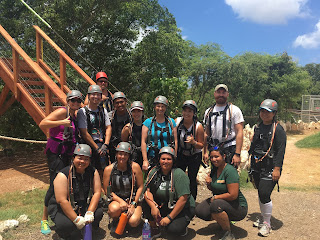May I Have the Floor?
Then, we showed a picture of a classroom with flexible seating.
 |
| Flexible seating in Mr. McNeeley's classroom |
The groups were discussing and the room was buzzing, quickly it came time for the whole group share out. I was facilitating this moment and asked the room to share what they were talking about regarding the picture of flexible seating, through the lens of a handout we were using to support Tomlinson's definition of differentiation (the yellow paper I will come back to shortly).
The first participant shared her frustrations with the seating she has in her classroom and how difficult it is to create flexible spaces when she can't get the tables she wants. Fortunately, there were three VPs participating in the session, so they were able to hear her concerns.
Next, a woman raised her hand and asked, "May I have the floor for two minutes?". She then stood up and proceeded to present data she had found regarding the benefits of tables over single desks in the classroom and reiterated the first teacher's frustration that she wants tables, knows they are better, but cannot get them. I then encouraged them both to email administration with this data and their request.
 |
He did not use the yellow paper.
This teacher launched into a diatribe about how he has had to move classrooms three times in the past three years and these decisions really affect his ability to build an environment that supports differentiation. His point is valid, but we have clearly strayed off topic.
Finally, a fourth teacher enthusiastically waved her had back and forth and told me, "my comment relates to the yellow paper".
After the meeting, the third teacher apologized for sharing his frustrations in a large group setting. But I told him not to apologize, these workshops are safe places for teachers to voice their frustrations, as well as their successes. It is a place to be heard.
As the facilitator I had a choice to make while these teachers were sharing: I could dismiss them as negative, complainers not doing the activity as planned or I could listen, hear their points, understand their challenges and then challenge them to push through. Our motto is 'teachers empowering teachers' and to empower, we need to listen to understand and support growth. And of course, without trust, deep learning cannot occur.



Comments
Post a Comment